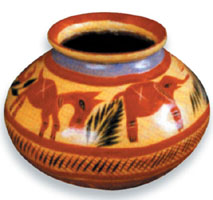Sakher Hanri
Sakher Hanri painted earthenware pots. This is one of the oldest folk arts in the country; the Chinese traveller Ma Huen, who visited Bengal in 1406 AD, mentioned this art in his travel accounts. Sakher hanri is also known as 'sakher chukai' or 'jhanpi'.

Sakher hanri are used to carry gifts of fruits and sweets at weddings. In the nawabganj area, new mothers are presented with sakher hanri when leaving their father’s home after the first childbirth. Two other pots, sikar handi and bata are also presented with sakher hanri.
There are two forms of sakher hanri, one from the Banya and Basantapur areas of rajshahi and Baroghanria of Nawabganj and the other from Bangal Para of naogaon. Sakher hanri from Banya, Basantapur and Baroghanria display fish, birds, half-blossomed lotuses and daldam (a sort of aquatic grass) drawn in red, blue, green and black on yellow-coloured pots.
At Bangal Para artisans paint stars in black and white and fish, combs, birds and lotus in mustard-yellow on red-coloured pots. Among 80 to 90 households of kumars (potters) at Bangal Para, there are around eight to nine Vaisvava families engaged in making sakher hanri. [Tofael Ahmad]
